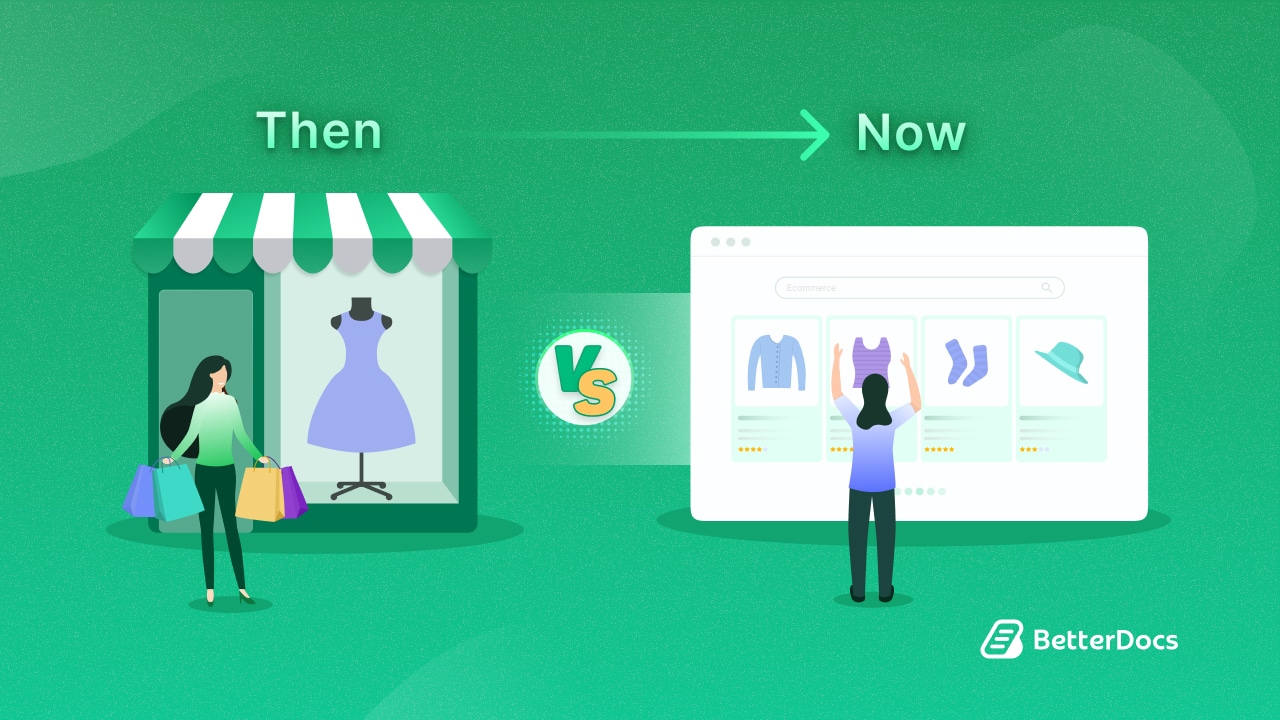Customer preferences as well as our world are always changing, which is why there have been significant changes in customer engagement. In the last decade, some major incidents have happened that have entirely reshaped the way customers engage with businesses and stores alike. Today we will discuss the major 5 shifts in customer engagement that you should take a look at and start adopting in your customer experience journey.

Here’re the Factors Causing Shifts in Customer Engagement over the Decades
If you look back at the past decade, many things have changed, including customer behavior and tastes. Among all those major catalysts, 2 factors are worth mentioning that have caused major shifts in customer engagement for different types of businesses.
🦠 COVID-19 Has Entirely Changed Customer Behavior
Yes, COVID and the pandemic might no longer be major causes of casualties around the world, but their effects on all aspects of life cannot be reversed. In every aspect of business, from organizational structure to customer behavior to marketing strategies, everything has changed due to its impacts. The conventional approaches to regular day-to-day businesses and work were unhelpful in the pandemic period. As a result, companies and customers had to look for alternatives. And some of those practices are still maintained in every sector, even after COVID has died down.
According to McKinsey’s consumer sentiment survey, consumers across the globe have responded to the coronavirus crisis and its associated disruption to normal consumer behaviors by trying different shopping behaviors. They also express a high intent (65 percent or more) to incorporate these behaviors going forward.
🤖 Launch of ChatGPT Has Opened Up New Opportunities
While artificial intelligence (AI) is not a new concept today, ChatGPT’s 2023 launch has made it one of the hottest topics, changing the way people do things. ChatGPT has provided AI accessibility to a range of customers. Every sector of business and shopping has been flown over by AI usage in writing, planning, and marketing. And this has created a great impact on customer engagement and behavior as well.

5 Key Shifts in Customer Engagement You Need To Check Over Decades
We have gotten a glimpse of the major factors that resulted in shifts in customer engagement. But what type of shifts have we seen? Time to look up the key shifts.
Through the use of our customer engagement tools to interact with customers globally and our own market research, we have identified several tendencies. These shifts in customer behavior and involvement appear to be widespread across many geographies and industries. Let’s check out our hand-picked the most significant shifts in customer engagement over decades and what marketers need to do now.
1. Moving Towards eServices & eCommerce More
A few years ago, we couldn’t anticipate that purchasing things and taking services could be done online. But perspectives have changed now. Homemakers can buy vegetables online rather than selecting them by hand from a local seller, while baby boomers can now buy their medications online without having to leave the comfort of their homes.
eCommerce statistics of present years by Forbes portray the shifts in customer engagement:
- The Growth in Retail eCommerce Sales Worldwide 2021-2026 increases from $5.2T to $6.9T. And it will be $8.2T in upcoming years.
- 8% of retail purchases are expected to take place online in 2023.
- Amazon accounts for 37.8% of e-commerce sales, the highest market share of all e-commerce companies.
- 79% of shoppers shop online at least once a month.
Not only are people buying more products online, but they are also using online services more often. In previous years, consumers have already begun to actively use eServices for banking, travel or hotel booking, medical purposes, leisure, etc. During the lockdown, a lot of other industries that had fallen behind, such as medical consultation, on-demand professional services, education, etc., quickly caught up.
This trend is probably here to stay because e-commerce is safer, more cost-effective, and more efficient than purchasing from physical storefronts. Many would rather purchase from the comfort of their couches than venture outside.
👉 How Can Businesses Cope with the Changed Customer Experience?
Companies should start bringing their businesses online, despite having physical stores. And be more focused on digital channels. For companies that are just getting started in the digital world, improving the online purchasing experience should be their top priority. This includes making necessary improvements to their website and app, adding flexible payment options, and streamlining their logistics and customer support systems.
It is also critical to rethink analytics and customer engagement. Although customers may have joined during times of hardship or emergency, you must establish long-lasting relationships with them. It will help to retain your business. To handle the new surge of data that can be tracked from your online storefront and leverage it for more individualized client encounters, your business needs to prepare itself better.
2. There Is a Decline in Brand Loyalty
Customers’ brand loyalty has shifted due to a variety of causes, including product shortages, supply chain interruptions, an increase in e-commerce possibilities, safety concerns, etc. We can observe these while visiting physical stores and in tight financial circumstances. Due to the pandemic, customers have changed brands, retailers, and shopping habits all over the world. Regaining those clients is undoubtedly difficult, particularly for more established and mature brands that have seen their clientele eroded by smaller and more recent offerings.

👉 How Can Businesses Cope with the Changed Customer Experience?
Consumers’ brand loyalty is influenced by a variety of variables, too, including connection to the brand, competitive pricing, competitive customer service, and product quality. Currently, a brand’s ability to retain customers or lose them hinges on how those customers “feel” about it.
Thus, the brand communication plan is much more important in the modern world. Although organizations need to guarantee customized communication, the consumer engagement solutions they use ought to go beyond that. Astute marketers are already building and maintaining a brand image that conveys their genuine concern for their patrons, local community, and society at large. It will affect not just how they survive the epidemic but also in the aftermath of the event.
Building Seamless Omnichannel Experiences Will Increase Brand Recall
3. Growing Role of AI in Crafting Personalized Customer Experiences
Artificial intelligence (AI) is changing every aspect of our lives and creating new opportunities for consumer interaction. As a result, businesses are using AI to anticipate demands and provide individualized client experiences. AI-enabled operations improve cross-sell and up-sell opportunities and lower costs for AI-driven enterprises.
From machine learning to video processing, intelligent customer experience platforms are using every tool at their disposal to provide integrated, enhanced, and comprehensive client experiences at a reduced cost. AI can be used to streamline customer selections, direct users to the optimal option or channel, fully automate processes like chatbot customer support, and more. AI is also being used by CEPs to help equip their customer care personnel to interact with customers more quickly and effectively.
👉 How to Grab this Opportunity to Enhance Customer Engagement?
Brands may now use location, audio, video, and image data in conjunction with AI to create more human-like and highly customized offers and experiences. Through predictive analytics, AI is enabling brands to anticipate customer demands, thereby elevating customer engagement.
What you can do is simply start using AI, from targeting leads to onboarding new customers. If you are working in the customer experience sector, then you should inspire your developer team to study AI and try to implement it in every possible place. And as a marketer, you should start taking help from AI tools for making decisions, refinishing campaigns, content, etc. Basically, we all should adopt AI in our everyday lives.
4. Moving Towards Brands with Personalized Experiences
In past decades, as users, we used to get happy seeing our ‘First Name’ at the start of an email. However, the definition of a personalized customer experience has changed. And customer engagement is rising abruptly for the brands that are providing customized experiences.
For businesses, personalization is essential since it fosters a closer relationship with clients and improves their experience in general. By customizing products, recommendations, and marketing communications to each customer’s unique interests and behaviors, you can make every customer engagement more relevant and engaging.

Your customer interaction plan will be more successful if it takes a personalized approach, which will strengthen customer engagement ties and boost loyalty and satisfaction. Furthermore, profitability and business growth are driven by customization. Businesses may dramatically increase the return on investment (ROI) of their marketing operations by providing tailored messages and recommendations that are based on customer data and behavior.
👉 How to Grab this Opportunity to Enhance Customer Engagement?
How do you spread the word about personalized experiences for your customers, whether you already offer them or plan to do so? The best way to do this is by utilizing your company website. Your brand’s website is crucial to the customer journey. Every step of the way, whether it is product discovery, acquisition, engagement, or repurchases, customers expect a customized and individualized experience.
Integrating the customer experience platform into the acquisition funnel can be the best solution. Creating ads targeting niche customer buyer personas, providing one-to-one communication threads, etc. can help you boost customer engagement and skyrocket your sales.
5. More Keen on Transactional Messaging to Elevate Efficiency
Do you recall the days when we used to write letters and wait a long time for a response? It will look ridiculous in this decade to be unaware of the status of your goods delivery. Additionally, where transactional messaging is used, customer engagement is rising quickly.
Nowadays, customer engagement is heavily reliant on transactional messaging. These communications, which can range from order confirmations to delivery updates, are crucial for establishing a relationship of trust and longevity with your clients. It is crucial to optimize transactional messages for relevance, timeliness, and clarity. Well-written messaging helps to create a positive brand image in addition to meeting transactional objectives.
👉 How to Grab this Opportunity to Enhance Customer Engagement?
Businesses should think about investing in plug-and-play transactional messaging infrastructures to save overhead and development expenses. Although developing an internal solution is feasible, you will have an advantage over your rivals if you can guarantee send rates of less than three seconds, uptime of 99.999%, and go live in less than a week.
Additionally, an enterprise must have a single platform that facilitates the management of transactional and promotional messaging. You have an overview of every communication a customer has with your brand, thanks to a single platform. Using content templates promotes consistent branding and aids in centralized campaign administration.
Excel In Customer Engagement by Adapting These Shifts
Despite the erratic nature of recent patterns and the uncertainty surrounding the upcoming quarters, marketers possess sufficient information to adjust to the new normal. After all, the pre-pandemic state of affairs is not going to return. To create enduring relationships and promote brand loyalty, customer engagement and retention will remain crucial components.
What’s next? You can start exploring these shifts in customer engagement and start implementing the suggestions. Hopefully, all these will result in great customer satisfaction and scale up your business.
Want to keep getting these kinds of in-depth customer engagement guides? Then subscribe to our blog now.








